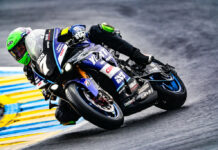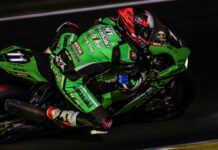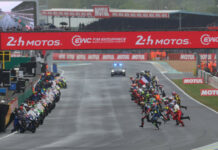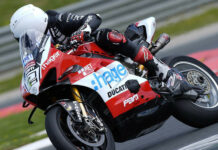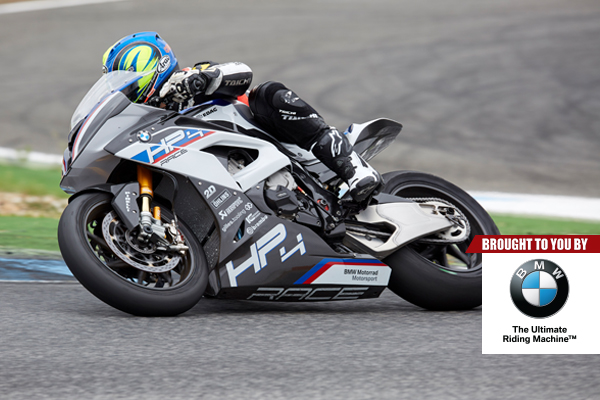This featured article is brought to you by BMW Motorrad USA.
This article was originally published in the August 2017 print issue of Roadracing World & Motorcycle Technology magazine, and is now being posted with sponsorship from BMW North America. To read more new bike test features like this, either in print or in a digital format, subscribe here: https://subscriber.pagesuite-professional.co.uk/su…
Editorial Note: BMW’s track-only HP4 RACE was an unprecedented technological marvel when it was introduced for retail sale last year. It still is, and is available from BMW dealers across North America…
SPORTBIKE INTRO: 2018 BMW HP4 Race
Estoril, Portugal
The BMW Way
By Chris Ulrich
Copyright 2017/2018, Roadracing World Publishing, Inc.
I was skeptical of BMW’s carbon-fiber frame project when the HP4 Race concept was announced in the fall of 2016. Others manufacturers had tried to build motorcyles with carbon-fiber frames, and ultimately failed to create a machine that was user-friendly. The history of motorcycles with carbon-fiber frames goes back to the late 1980s when Cagiva Mito built a two-stroke 500cc Grand Prix racebike with a carbon-fiber frame. A more recent example of a carbon-frame motorcycle experiment would be the famous abandonment of the composite material by the Factory Ducati MotoGP team during Valentino Rossi’s tenure on the Desmosedici. But while it didn’t consistently work for Ducati in MotoGP, the brand has stuck with carbon-fiber for the super-high-end, limited-production Superleggera, which seems to be doing pretty well. And obviously, the struggles other brands have had in the past with composite frames have not deterred BMW from building a sportbike based on the S1000RR, with a carbon-fiber main frame.

Chris Ulrich exits Estoril’s first-gear chicane on the carbon-fiber-framed BMW HP4 Race. Maps limit throttle opening in lower gears to improve drivability.
It can be argued that there isn’t a company better equipped to tackle a carbon-fiber main-frame project for a production motorcycle and do it right. BMW was the first to industrialize the use of structural carbon-fiber componentry in mass-produced cars such as the M3, i8, and electric i3, so company engineers have experience with the composite material.

BMW engineers worked to create a carbon-fiber frame that had the right rigidity balance to deliver good feel for the rider in all sections of the corner.
BMW initially introduced the high-performance HP4 production model in 2013, then incorporated the HP4’s upgrade into the S1000RR model update in 2015. BMW product planners and managers knew they needed to do something spectacular to create the next generation HP4, and they decided to go big, with a carbon-fiber main frame, and a race-spec engine. Elmar Jager, who works in the pre-development department at BMW Motorcycles, brought up the concept of a carbon fiber framed S1000RR. From there it was left up to Josef Maechler, who is in charge of Product Sales Strategy and Product Management for BMW Motorcycles, and Rudolph “Double RR Rudi” Schneider, Head of 4- and 6-cylinder Product Projects, to figure out if it was possible. They did and they named it the HP4 Race.

The HP4 Race mates a carbon-fiber frame with an underslung-design aluminum swingarm made by Suter Racing. Note the eccentric swingarm pivot position adjusters.
Christian Gonschor, a 37-year-engineer with racing department experience, became the HP4 Race Project Leader. His mission was to bring lightweight material technology in motorcycles to the next level with a carbon-fiber main frame that retained the feel needed for a rider to push the limits of the bike. And his assignment brief included doing it in only two years. Easy task, right?

Christian Gonschor, 37, is a racing engineer turned HP4 Race Project Leader.
Gonschor was unfazed, seeing the assignment as an engineering exercise that would work if done right, explaining that he knew “if you do it the right way, The BMW Way, the rider will feel the pure reduction in weight and the improvement in riding dynamics.”

Top view of the HP4 Race on track. Engineers tuned HP4’s flex characteristics and front-end feel with the top-triple clamps.
Adding to the overall performance would be Öhlins FGR 300 Superbike forks, an Öhlins TTX 36 shock, a Suter swingarm, and World Superbike electronics. The result is a motorcycle that puts out a claimed 215 bhp at the crankshaft with an overall wet weight (including a full tank of fuel) of 377 pounds (171 Kg). By comparison, the minimum weight for a World Superbike after a race (with an empty tank) is 370.5 pounds (168 kg). The 2017 HP4 Race is a very light motorcycle, built for performance and performance only.

The BMW HP4 Race features Öhlins FGR 300 forks, Brembo GP4 PR Calipers, and 320 mm Brembo T-drive brake discs.
Development focused on retaining the balance between frame rigidity and feel. To achieve this BMW engineers used Resin Transfer Molding (RTM). It’s a process in which a blend of non-woven carbon-fiber fabric with continuous fibers is placed in a large vacuum mold, (along with frame hardware), and a precise amount of resin is injected into the mold. The use of RTM gave BMW engineers the ability to mass-produce one-piece carbon-fiber frames without any inconsistencies in the performance from one unit to the other. The end result is a main frame with similar feel and flex characteristics when compared to the S1000RR’s aluminum frame while weighing 7.8 kg (17.1 Pounds)—which is about 8.8 pounds lighter than the conventional aluminum frame.

Resin transfer molding (RTM) made it possible for BMW to mass produce the one-piece carbon-fiber frame used for the 2018 HP4 Race.
Make no mistake: It may be too light for the Superbike World Championship, but the HP4 Race is a production racebike legal for use on public-road courses as seen on the Isle of Man and in Macau as well as in the Endurance World Championship and assorted regional and club racing series. It comes with all the adjustability a Superbike team could need to customize the motorcycle to the rider’s needs. Or, in some cases, enough adjustability for riders to spin themselves into outer space with the motorcycle set-up!
As delivered, the HP4 race has 30 mm of offset and the rake set at 23.5 degrees, which places the trail at 102.5 mm. BMW offers offset inserts that range from 26mm to 32mm, in 2mm increments. Rake can be adjusted in .5 or 1-degree increments on either side of the zero setting of 23.5 degrees. More adjustment is available at the rear of the HP4 with the option of moving the swingarm pivot up or down 4 mm, in 1 mm increments. That is a lot of adjustability!
World Championship-level Öhlins FGR 300 46 mm inverted forks with C2 (compression)/ R4 (rebound) valving and 10.5Nm springs come standard on the HP Race. At the rear the fully adjustable, large-body Öhlins TTX 36 GP shock comes with C6/R7 damping specs and a 95Nmm rear spring.
As feel and total chassis balance is important, BMW engineers paid close attention to the design of the Suter-manufactured aluminum swingarm while developing the HP4 Race. The swingarm is based on the underslung designed unit used in the Superbike World Championship, except the version used on the HP4 Race was optimized to work with the carbon fiber main. Overall length of the swingarm is a relatively short 604 mm.

The rear view of the 2018 BMW HP4 Race. The shape of the front fairing and seat/tailsection are identical to the parts on the S1000RR.
Additional weight savings was achieved on the HP4 Race by fitting carbon-fiber wheels built using a process known as braiding, where one piece of fabric is wrapped in place by a machine. A dense foam is also inserted into the wheel spokes to reduce vibration. The end result is a set of wheels that are 30% lighter than aluminum racing wheels, reducing the gyroscopic effect of the rotating wheel, which theoretically improves the turning and transitioning of the bike. BMW engineers were careful to retain the same rigidity as existing aluminum wheels in order to not reduce feel or create chatter or grip problems at full lean.
More World Championship level components were used for the brake system, with Brembo GP4 PR brake calipers that are actuated by a billet aluminum Brembo RSC 19×18 master cylinder. The brake calipers clamp onto a set of 6.75 mm thick, 320 mm Brembo T-drive discs rotors. The bottom-mounted Brembo rear brake caliper features four pistons and works with a 4mm—thick 220 mm rear disc.

The front view of the 2018 BMW HP4 Race. The shape of the front fairing and seat/tailsection are identical to the parts on the S1000RR.
Adjustable race ready controls from Alpha Racing are used for the 7-degree-bend clips-ons along with fully adjustable rearsets. The rear subframe and seat assembly are made out a woven carbon fiber using a conventional lay-up technique. Using carbon fiber allowed BMW to easily build in seat adjustments in 15 mm increments. The HP4 Race is delivered with seat position at 32.7 inches (831 mm) and there is an option to lower the seat to 32.1 inches (816 mm) or raise the seat to 33.3 inches (846 mm), depending on the rider’s preference.
At the center of the HP4 Race is a race-tuned version of the S1000RR’s DOHC four-cylinder engine with an 80 mm bore and 49.7 mm stroke, displacing 999cc. The HP4 engine uses a combination of what BMW calls the 6.2 and 7.2 engine specs, and puts out a claimed 215 bhp at 13,900 rpm, at the crankshaft—or about 16 more horsepower than the S1000RR streetbike engine. The HP4 Race engine also makes 5.1 lbs.-ft. more torque than the S1000RR, putting out a claimed 88.5 lbs.-ft. at 10,000 rpm. While BMW engineers were tight-lipped about the valve timing and lift numbers, I can tell you that the 6.2 valve train is used in the Endurance World Championship and is designed to increase performance by allowing the redline to be to 14,500 rpm, while maintaining reliability as the miles pile up. Information on the compression ratio is also somewhat vague, with BMW claiming the ratio is between 13.7:1 and 13.9:1. To broaden the power curve, BMW uses its own version of electronically controlled variable-length intake funnels (a.k.a. velocity stacks) with the transition from long (for acceleration) to short (for top end) taking place at 11,500 rpm. The Akrapovic 4-2-1 titanium racing exhaust system comes with a carbon fiber muffler.
The 7.2 bottom end comes from the Superbike World Championship program and is designed for durability and performance. As with all racing engines, careful attention was paid to sizing the plain main bearings to reduce mechanical losses without sacrificing durability. The crankshaft itself has been lightened by 200 grams compared to the standard S1000RR crank by removing material from the counterweights and from the primary drive sprocket on the right side of the engine. These modifications help increase acceleration, and also reduce the amount of force required to stop the HP4 Race. BMW uses Shell 0w40 high-performance oil to reduce further mechanical losses.
Radiator size is the same as on the standard S1000RR, but the water pressure has been increased from 1.2 bar (17.4 psi) to 1.8 bar (26.1 psi) through the use of a high-output water pump. The added pressure circulates the water faster, which helps raise the boiling point of the coolant.
More racing carryover can be found in the transmission of the HP4 Race. Gear ratios for first and second are taller for racetrack use when compared to the standard S1000RR parts. Third gear remains the same, while fourth through sixth gears are shorter. The primary gear ratio was unchanged; see the spec chart for ratios. Like most racebikes, the HP4 Race is set up for GP shift pattern (up for up) when delivered, and comes with the auto-blip function enabled for clutch-less up-shifts and down-shifts.
Each engine is expected to last 5,000 km (3,100 miles) before needing to be replaced. If you take into account that the average track-day rider or club racer rides between 100-300 miles per weekend and does about five weekends per year, you are looking at an engine life of three to five years before needing a replacement. BMW representatives claim they will offer an engine exchange program through BMW dealers at a cost of $10,000 to $15,000 per engine.

Traction control and engine braking settings can be changed on the fly using switches on left handlebar.
A motorcycle with cutting edge chassis design and a powerful engine needs an electronic suite to match. The HP4 Race comes standard with an electronic package similar to what the brand uses in the Superbike World Championship. As delivered, the system comes with four riding modes: Wet, Intermediate, Dry1 and Dry2. Each mode has different throttle maps that control wheel torque (a.k.a. power delivery) by limiting the throttle butterfly valve opening. In Rain mode, throttle opening is limited to 67% in first gear, 71% in second gear, 75% in third gear, and 95% in fourth gear while fifth and sixth allow full throttle. The throttle map in Intermediate Mode is opened up slightly with 71% opening available in first gear, 79% in second gear, and 88% in third gear, while fourth through sixth allow 100% throttle opening. Dry1 mode allows 75% opening in first, 83% opening in second, and 93% opening in third with full throttle available in fourth through sixth. The Wheelie Control function is also active in all gears in Rain, intermediate, and Dry1 mode. Dry 2 mode’s map throttle progression is even more aggressive; first gear is limited to 75% throttle opening, but then the map jumps to 92% throttle opening in second, and 96% throttle opening in third. Full power is available in fourth, fifth, and sixth gear. The Wheelie Control function is only available in first and second gear in Dry 2 mode. The advantage of controlling wheel torque by proactively limiting the throttle opening is a smoother and faster drive without needing the ECU to cut power to allow the tire to recovery after a slide.
Further control of the power on the HP2 Race comes standard from BMW’s Dynamic Traction Control (DTC) system, which offers 15 levels of intervention, (+-7 plus 0). Inputs taken from the IMU and wheel speed sensors detect wheel slip. Once slip conditions are present, the ECU reduces power by removing spark and closing the throttle valves.
Further help keeping the front wheel on the ground in the acceleration zone comes from five levels of Wheelie Control. Like with the DTC, the wheelie control relies on inputs from the IMU and wheel speed sensors to detect when wheelie conditions are present, then removes power according to the level selected.
Fifteen (+-7 plus 0) levels of engine braking control are also standard on the HP4 Race. The system provides plenty of options; maps can be modified for each gear using the HP calibration.
Other racing features available from the electronics system are a pit-lane speed limiter and launch control. All the functions can be adjusted on the fly through racing-style switch units mounted on the handlebars. The three-button switch on the left handlebar allows the user to toggle between rider aids, then change the selected rider aid on the fly. The right handlebar switch has the kill switch on top in red, and the pit-lane speed limiter in the center; the bottom button is used to toggle between riding modes. The throttle must be closed to change the riding mode while on the racetrack.
The BMW HP4 Race comes with a 2D dashboard that indicates engine rpm, map, EBR level, DTC level, water temperature, predictive lap, and lap time. The screen can be customized for the rider’s needs. Data is logged using though the 2D system and stored on an easily accessible USD memory stick. BMW also offers the option to purchase additional sensors, including linear potentiometers to read suspension travel and brake-pressure sensors. Each additional sensor comes with the extra wiring and connectors required for easy fitment.
BMW will produce 750 units of the HP4 Race worldwide that will be available to order on a first-come, first-serve basis. While BMW North America hasn’t released the official MSRP, the HP4 Race should be priced somewhere around $88,000 U.S.
Riding The HP4 Race
The intro day at Estoril consisted of five 20-minute riding sessions, and we had to spend two sessions on the standard BMW S1000RR before being let loose on the HP4 Race. Extra time on the standard S1000RR streetbike suited me fine as it allowed me to learn the Estoril Circuit on a slightly less aggressive machine.
Estoril’s layout is pretty straightforward, with a few blind exits and one really, really slow chicane a couple of corners before the front straight. The Portuguese track is 4.182 km (about 2.6 miles) in length and has 13 turns, with nine rights and four lefts. The surface is old and the track seems narrow, especially when compared to many more modern Grand Prix circuits. But it is an old school European circuit, with old-school flow, like Jerez or Catalunya (before they put the new chicane in).
Members of the press delegation were sent out for their first session on the HP4 Race with the ride mode set on Intermediate, DTC on level 5, and EBR on level 2. It had been more than 12 months since I threw a leg over anything that resembled a racebike, so spending the first few laps using softer throttle maps while I again got used to riding on a high-horsepower, stiff-chassis motorcycle helped me get comfortable with the bike without any big surprises.
Power delivery in intermediate mode was docile in the first three gears, and then it felt like hitting the afterburners once the throttle was allowed to open fully coming onto the front straight. There was a lot of intervention coming from the traction control and wheel control with the DTC turned up in Intermediate mode. However, the cuts were smooth and always ahead of the engine, and it was clear that the bike was removing power before the tire had a chance to start sliding in the acceleration zone.
My initial impression of the chassis was also positive; the HP4 Race fell into the corner with much less effort than required to turn the standard S1000RR. In fact, it turned so quickly on my first lap that I had to adjust my turn-in rate to keep from running over the inside curb! Transitioning from side to side also required less effort when compared to the S1000RR. This is the big advantage of lightweight carbon-fiber wheels.
I switched to the Dry1 mode three laps into my first session on the HP4 Race. Power delivery was still manageable, but with the more aggressive throttle maps available. With more power, there was slightly more intervention from the DTC, so I turned it down to help me slide the rear tire to finish the corners. The HP4 Race also wheelied slightly more in this setting, causing the WC to kick in, with the system allowing the front tire to just skim the top of the pavement without any massive power cut. It actually worked very well.
As my speed increased on the bike during my three sessions, I increasingly found myself riding the bike like I would ride my old MotoAmerica Superbike. The chassis had great braking stability and plenty of front-end feel to allow me to trail-brake all the way to the apex without any drama. There was also plenty of feel at the apex at full lean in both slow and fast corners. Once the bike was rotated and I had my direction set, I could start to feed the throttle in without any hesitation. The combination of Pirelli tires and good chassis flex characteristics provided plenty of feel to allow me to start opening the throttle while still on the side of tire. Slide characteristics though the acceleration zone were predictable, giving me plenty of confidence to light the rear tire up to help finish the corner when needed.
BMW’s carbon-fiber experiment actual performs the way a bike should. It has the right balance of rigidity and feel needed to push the chassis, and components from Öhlins and Brembo worked as expected from industry-leading manufacturers. Adding World Superbike-level electronics and a high-spec engine make the BMW HP4 Race an extremely potent racetrack machine.
The BMW engineers did it their way—and did it right.
Specifications: 2018 BMW HP4 Race
Engine Configuration: Inline Four, 4-stroke.
Engine Displacement: 999cc
Engine Cooling: Liquid
Compression Ratio: 13.7-13.9:1
Combustion Chamber Design: Pentroof
Valves Per Cylinder: 4
Intake Valves Per Cylinder: 2 (Titanium)
Exhaust Valves Per Cylinder: 2 (Titanium)
Bore x Stroke: 80.0 mm x 49.7 mm
Connecting Rod Length (center-to-center): 103.0 mm
Connecting Rod Material: Steel
Engine Redline: 14,500 rpm
Claimed Horsepower: 215 bhp @13,900 rpm
Claimed Torque: 88.5 lbs.-ft. @ 10,000 rpm
Valve Angle (Included): 11.2 degrees Intake/13.3 degrees Exhaust (24.5 degrees)
Combustion Chamber Volume: 19.5cc
Valvetrain Type: DOHC, Reduction Gear And Link-plate Chain Drive, Finger Followers, Shim-in-retainer Lash Adjustments
Intake Valve Diameter: 33.5 mm
Exhaust Valve Diameter: 27.2 mm
Intake Valve Stem Diameter: 5.0 mm
Exhaust Valve Stem Diameter: 5.0 mm
Valve Timing Measurement Point (lift): 3.0 mm
Fuel Delivery System: BMW BMS-K-P Digital Fuel Injection
Throttle Body Venturi Size: 48 mm
Air Filter Type: Pleated Paper
Exhaust System Type (Material): 4-2-1 (Titanium)
Ignition System: Digital
Lubrication System: Wet Sump
Oil Capacity: 4.1 quarts (3.9 liters)
Fuel Capacity: 4.6 gallons (17.5 liters)
Transmission Type: 6-speed, Constant Mesh
Clutch Type: Multi-plate, Wet, Back-torque-limiting
Clutch Actuation System: Cable
Clutch Spring Type: Coil
Number Of Clutch Springs: 6
Number Of Clutch Plates: 19
Drive Plates: 10
Driven Plates: 9
Primary Drive: Gear (Straight-cut)
Primary Drive Gear Teeth (Ratio): 76/46 (1.652:1)
Final Drive Sprocket Teeth (Ratio): 43/16 (2.687:1)
Transmission Gear Teeth (Ratios):
6th: 31/24 (1.291:1)
5th: 35/25 (1.400:1)
4th: 34/22 (1.545:1)
3rd: 38/22 (1.727:1)
2nd: 44/22 (2.000:1)
1st: 43/18 (2.388:1)
Transmission Overall Ratios:
6th: 5.730:1
5th: 6.214:1
4th: 6.858:1
3rd: 7.666:1
2nd: 8.877:1
1st: 10.600:1
Theoretical Speed In Gears At Redline:
6th: 186 mph
5th: 172 mph
4th: 156 mph
3rd: 139 mph
2nd: 120 mph
1st: 101 mph
Engine Speed At 60 mph: 4,673 rpm
Frame Design (Material): Twin-Spar (Carbon Fiber )
Rake/Trail: 23.5 degrees/4.03 inches (102.5 mm)
Offset: 30 mm
Claimed Wheelbase: 56.69 inches (1,440 mm)
Claimed Swingarm Length: 23.77 inches (604 mm)
Seat Height: 32.7 inches (831 mm) (as delivered)
Front Forks: Öhlins FGR 300, Inverted, Cartridge
Fork Tube Diameter: 46 mm
Fork Adjustments:
Rebound Damping: 25 Positions (Clicks)
Compression Damping: 25 Positions (Clicks)
Spring Preload: 15 mm Range
Front Wheel Travel: 4.7 inches (120 mm)
Rear Wheel Travel: 5.1 inches (130 mm)
Rear Suspension Type: Öhlins TTX 36 Single Shock, With Linkage
Rear Shock Adjustments:
Rebound Damping: 25 Positions (Clicks)
Compression Damping: 25 Positions (Clicks)
Spring Preload: 15mm Range
Front Brakes: 320 mm (12.6-inch) Dual Discs, 4-PistonRadial-mount Brembo Monobloc Calipers
Rear Brake: 220 mm (8.7-inch) Disc, Four-piston Brembo Caliper
Front Wheel: 3.50 x 17.0-inch Braided Carbon Fiber Composite
Rear Wheel: 6.00 x 17.0-inch Braided Carbon Fiber Composite
Front Tire: 120/70-ZR17 Pirelli Diablo Superbike Radial Slick (SC2 Compound)
Rear Tire: 200/60-ZR17 Pirelli Diablo Superbike Radial Slick (SC2 Compound)
Claimed Wet Weight: 377 pounds (171 kg)
Overall Length: 81.4 inches (2070 mm)
Overall Width: 30.5 inches (777 mm)
Overall Height: 46.9 inches (1193 mm)
Suggested Retail Price: N/A (Est. $88,000 U.S.)
This article was originally published in the August 2017 issue of Roadracing World & Motorcycle Technology. To read more new bike test features like this, either in print or in a digital format, you can subscribe here: https://subscriber.pagesuite-professional.co.uk/su…


